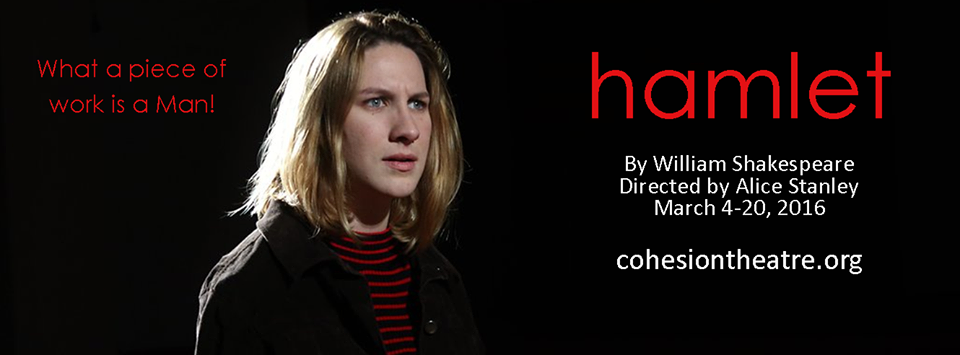The mayhem never stops over at Cohesion Theatre Company and their latest mount to the stage is truly wondrous strange. Taking William Shakespeare’s Hamlet to task, Director Alice Stanely refocuses the driving forces of the plot’s actions and tunes them into the highly potent pathos of grief. Coping with loss is never easy, and the ways in which human beings express these feelings are nothing short of evocative, stirring, and daringly dramatic as witnessed in this production. Pared to its essentials with a cast of only 11 players, Cohesion’s Hamlet carves out the essence of grief, eviscerating these emotional responses from the characters and bathes the audience with the gory entrails of loss’s innards. A truly harrowing and striking performance, Hamlet in a way yet experienced, Director Alice Stanley and her ensemble and production team are begging the confusing questions we all so desperately seek during those times of inconceivable and inconsolable loss and filtering it through Shakespeare’s heaviest tragedy.
Drifting out of Denmark proper from the times of the Bard, Stanely and The Design Team shift the production to 1993 Seattle and infuse the atmosphere with appropriately selected 90’s grunge rock music to backlight the audio scene of the show. But the major temporal shift is witnessed most keenly in Costume Designer Katherine Beem’s approach to the production. The 90’s, like many of the decades that arrived on the fashion scene after it, lacks a truly definitive characteristic for its traditional togs, but Beem finds little iconic ways of working out the spatial displacement in the vein of “emo.” Hamlet’s threads in particular have that moody-punk-teen feel to them, with the shredded-knee denims and the henna-lace neck choker. Beem tucks the 90’s into all the stitches she can, keep an eye on the more notable bands of that genre-focused era, specifically when it comes to the Puppets of Rosencrantz and Guildenstern.
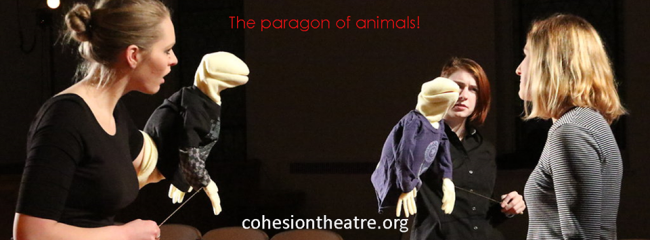
Consulted upon by Jeff Miller, the freakishly faceless puppets of Rosencrantz and Guildenstern (worked by Casey Dutt and Jane Jongeward) are really the only element that feels out of sorts with itself when it comes to the production as a cohesive unit. While Stanley’s intent behind them as clear— as the characters themselves do not take up the puppets until they are set to the employ of Claudius— it smacks awkwardly over symbolic overkill and just doesn’t quite fit with the rest of the brilliantly constructed flow and vision of the production. That said, Dutt and Jongeward do wonders with transferring their own expressions via hyper-animated facial movements and vocal cues, to imbue these faceless entities with the illusion of humanity, appropriate but again a hint trite.
In addition to being the show’s Director, Stanely serves as the show’s Sound Designer and works with Lighting Designer Lana Riggins and Shadow Puppetry Artist Lauren Engler to create some fascinating effects throughout the performance that hone in on little moments of untold story. Engler’s silhouette play is reminiscent of the shadow-animation featured in the recent Harry Potter and the Deathly Hallows film, which stirs up a fond and bittersweet sentiment for anyone culturally awakened to the Potter sensation. Stanely’s otherworldly audio insertions create disturbing moments of ethereal reality for the spirit of the departed King Hamlet and all encounters therein experienced.
But the most sensational portion of Stanley’s vision is not the sound work or overall exceptionally tight pacing but rather the silent vignettes captured between scenes. There are a handful of moments, many of which speak as loudly as the Bard’s finely posed words, carefully inserted into the play that illuminate moments of unwitnessed occurrence for the characters. The two most profound that draw to mind are the ghosting moment of King Claudius passing through Gertrude’s compact mirror and the moment when Laertes receives the letter of his father’s death. While these moments happen presumably off-stage in Shakespeare’s work, Stanely has given them a sonorous voice by turning them into almost cinematic motion captures flawlessly woven in-between scenes of action and dialogue. Moments of this nature, including a truly haunting one with Ophelia near the show’s natural conclusion, are made that much more intense by Riggins’ stellar lighting design.
To each player their part and to each fighter their fight. A nod goes in the direction of Fight Choreographer Brad Norris as he brings sophisticated sword-play techniques into the battle-ground finale between Laertes and Hamlet. Given the confined and intimate staging space upon which the production plays, it is no small feat to see such sharp combat delivered so cleanly and look so natural up on its feet. Norris gives the rough-and-tumble moment in the graveyard scene between Laertes and Hamlet a heavy punch as well when it comes to high activity.
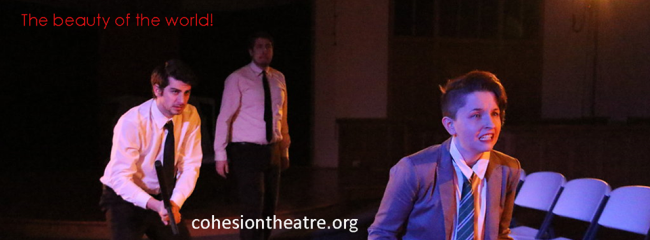
Ensemble players Jeff Miller and Matthew Payne, though but fleeting in their roles as the night guard or the king’s players, or in Payne’s case fiery young Fortinbras, hold their own in this production, managing to find the balance of their brief occurrences against the functionality of the plot. This is also true of Dutt and Jongeward, the aforementioned Rosencrantz and Guildenstern; all four of these performers handling most excellently the delivery of Shakespeare’s text while passionately making it relatable and translatable to the modern ear.
Lyle Smithers arrives on the scene dual-cast as first Polonius and later the Gravedigger. The irony of this casting choice is lost on no one, even if Smithers’ approach to Polonius is off-handed and dry. The wit contained therein does arrive with wry amusement, but it’s simple speech whilst taking to the role of Gravedigger that takes the attention to him in a fashion most pleasing. Martin Ealy also finds himself bestowed the honor of dual casting, though somewhat more traditional as he takes both crowns as Claudius and King Hamlet. Ealy, as the knave Claudius, appears initially like a provost lecturing the lackluster student body of Seattle Pacific when opening the funerary-nuptials speech at the top of the show. His command of fear and terror as King Hamlet surges forth as a force to be reckoned with, though it’s his moment as Claudius watching the player’s play that truly defines his emotional expressive abilities.
With the visions of loss circling about the production, the way principal characters come into play is askew from what is expected of a performance of Hamlet. Gertrude (Katherine Vary) and Horatio (Shannon Ziegler) orbit the pathos of Hamlet’s frustrations, and there are a great many moments, particularly in Vary’s case where the silent reactions expressed solely through facial expressions speak as strongly as words that are exchanged in the scene. While this is oft true of many of the performers in this production, it’s Vary’s iconic “bedroom closet scene” with Hamlet that draws all of that attention to Gertrude in this fashion.
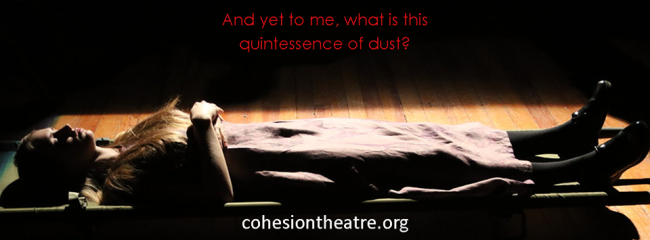
Ophelia (Sarah Lamar) who enters looking like a sun-child of Seattle, is another character caught in the orbital path of Hamlet’s feelings, though their interactions are much more intense and highly concentrated. Lamar is one of the pivotal plot-points of the “stages of grief” in this character map, and delivers spine-tingling haunted soul realness when it comes to losing her father. Often viewed as madness, Lamar transforms this scene— and her reprisal into something so much deeper than simply being driven out of the mind with grieving. A proper nod also needs to be given to Lamar for something that can only be addressed as “corpse breathing” when Ophelia is laid to rest, as there never appears to be any rising or falling of the chest for the duration of the scene.
Laertes (Melanie Glickman) suffers nearly as much loss as Hamlet in this production, if not more. Between father, sister, and the loss of friend, placement of self and overall standing in a world that makes sense, Glickman delivers all of these emotional experiences with raw and brutal honesty. As mentioned, the moment Glickman’s character receives the letter, Laertes’ unyielding tango with grief and loss begins, illustrated plainly upon her face. But it’s all of the subtler responses that Glickman expresses— like the momentary flicker of doubtful reconsideration that passes the eyes when confronted by Claudius to dispatch of Hamlet— that truly express the emotional depths of Glickman’s acting ability. A brutally harrowing scene to watch is Glickman’s unquashable conflagration of fury that arises as a tempestuous maelstrom when arriving and demanding to know what has happened to his father.
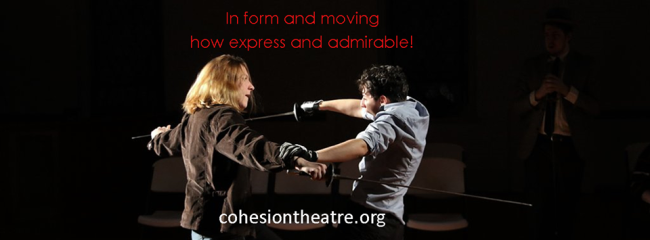
Unprecedented in the Baltimore Theatre Scene’s recent history is Caitlin Carbone taking on the title role of Hamlet. Phenomenal mastery does not begin to describe the surefire hold that Carbone possesses over the disturbed prince’s emotional war within himself. Awash in a rage of unapologetic subtext that surfaces so violently as to almost overtake Shakespeare’s words, Carbone doesn’t transport the audience through Hamlet’s voyage of grief and suffering so much as grabs the, by the scruff and rips them through it every painstaking step of the way. Setting word to action and action to word, Carbone punches up all of the sexual innuendos there are to be found, particularly in the exchanges with Ophelia during the player’s play scene— like textually expressing breakup sex— and does not shy away from the livid chip that burns on both shoulders when it comes to flippancy at both Claudius and Polonius. Carbone’s portrayal of Hamlet can best be summarized a beautifully chaotic explosion of one’s heart wrenched about in a blender and spewed out through the mouth in a delirious oblivion of grief-induced laments. Visceral, biting, and fearless, Carbone strikes blow after blow of this emotional upheaval and transforms Hamlet into something previously unexperienced.
This rich and deeply cathartic new vision of Hamlet is deeply satisfying, though heart wrenching, to anyone who has ever found themselves in a situation where loss, grief, or coping with those to titans becomes inexplicable. Remarkable work from exceptional talent, this is the Shakespearean production in Baltimore to see this spring.
Running Time: Approximately 2 hours and 40 minutes with one intermission
Hamlet plays through March 20, 2016 at Cohesion Theatre Company currently in residence at Church on the Square in Canton— 1025 S. Potomac Street in Baltimore, MD. Tickets can be purchased at the door or in advance online.

